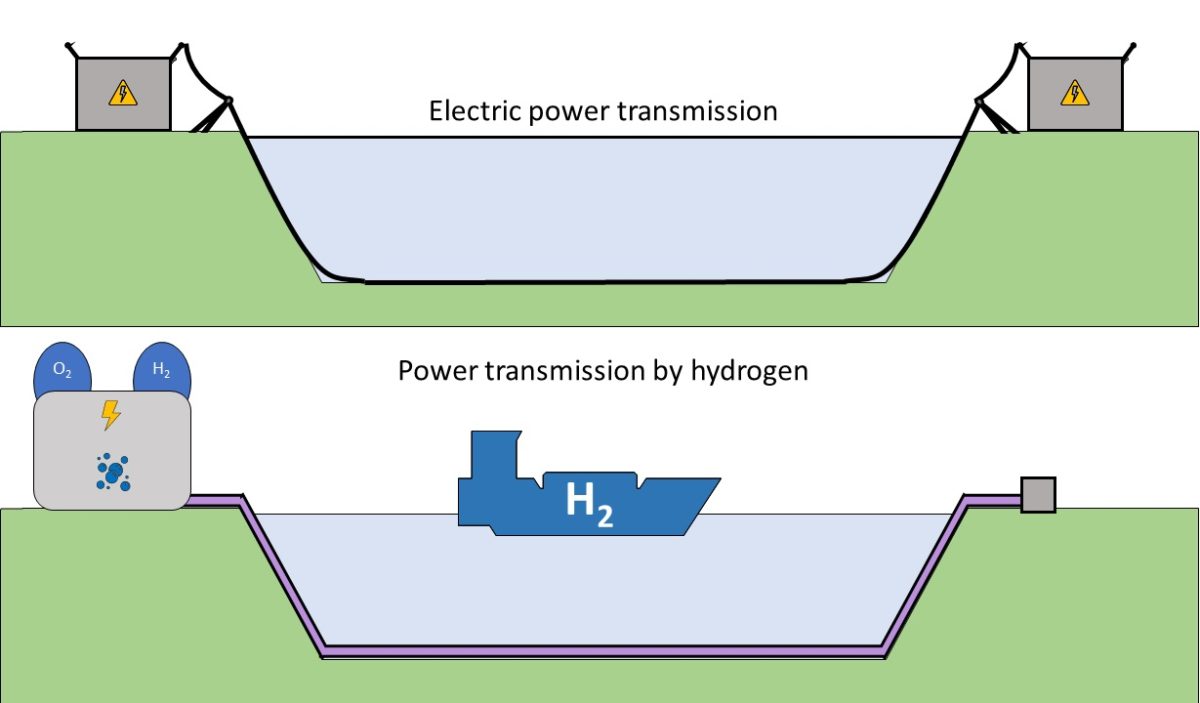An international research group has sought to establish which form of energy vector between hydrogen transport and high-voltage submarine cables is the most economical solution for energy transport among countries separated by water.
The scientists stressed that, as a general rule, the relative cost of electricity transmission, both in terms of power and distance, is higher than that for fuel transportation. They wanted to assess, however, if this principle would also apply to hydrogen transported through submarine pipelines or by ships in liquefied and compressed states, noting that transforming hydrogen into electricity does not happen without energy losses, and that hydrogen costs may vary depending on electricity prices. “The main source of losses originates from the electrolysis, regardless of the distance,” they stated. “For long distances, the permeation through the pipeline is noticeable.”
The researchers were also able to assess for the first time under which conditions it can be cheaper than the full electric alternative.
The academics outlined four different scenarios under three different electricity prices of $20/MWh or $5.6 per gigajoule (GJ); $40/MWh or $11.1/GJ; and of 60 $/MWh or $16.7/GJ. “The first two scenarios evaluated the power transmission of 2 GW between two shores separated by either shallow or deep waters,” they specified. “Whilst the remaining two scenarios analyzed the power transmission of 600 MW between an offshore platform, close to an offshore wind farm, and its hinterland, in shallow and deep waters.”
Their analysis showed that the competitiveness of hydrogen transport increases when the distance between the two shores is higher, depending on the electricity price. For example, in the first scenario, called Onshore to onshore shallow waters, at a price of $20/MWh, the cheapest option, for short distances, is the electric cable. When a distance of 1,690 km is crossed, however, hydrogen transport becomes the most competitive solution. At a price of $40/MWh, the hydrogen pipeline becomes the best option after 2,100 km and at a price of $60/MWh the threshold shifts to 2,480 km.
In the second scenario, dubbed Onshore to onshore deep waters, the three thresholds were found to be 760 km, 960 km, and 1,160 km, respectively.
In the first of the two offshore-to-onshore scenarios, called Offshore to onshore shallow waters, the hydrogen alternative becomes more convenient after 3,640, 3,960, and 4,250 km respectively, while in the second Offshore to onshore deep waters scenario, the favorable conditions for hydrogen materialize after 1,990 km, 2,150 km, and 2,320 km, respectively.
“For the offshore-to-onshore in shallow waters and deep waters, with a power rating of 600 MW, the electric cable is clearly the best energy vector,” the research group found. “In contrast, for the onshore-to-onshore scenarios with power rating of 2 with the electricity price at the exporting end cheaper than $40/MWh ($11.1 /GJ), the hydrogen alternative of the liquefied hydrogen ship represents better prospects than the electric solution for distances above 2,000 km for shallow waters and 1,200 km, for deep waters.”
It also concluded that the best LCOE option for short distances is the submarine cable, while hydrogen sent by ship is preferable when the distance exceeds 1,000 km and electricity prices are low. “From the results of this analysis, it can be seen that, under the assumptions made, the compressed hydrogen ship alternative does not present very good prospects of applicability in the future, unless some disruptive technological breakthroughs are made to significantly drop the associated costs or increase the capacity of the compressed hydrogen ships,” the researchers affirmed.
What makes compressed and liquified hydrogen ships still attractive, however, is that they can export energy almost anywhere, and that electrolysis and liquefaction plants are relatively easy to expand compared to marine cables. “I think that hydrogen and electricity have specific niches where each energy vector performs better than the other,” research co-author Rafael d'Amore-Domenech told pv magazine. More chemical energy vectors will probably appear in the future, and depending on the boundary conditions of each application, the “ranking” of the energy vectors will vary, he added. “I do not believe that they will compete. Instead, I think that all the alternatives will harmoniously complement each other in the future green economy.”
The findings of the research were presented in the study “Bulk power transmission at sea: Life cycle cost comparison of electricity and hydrogen as energy vectors,” published in Applied Energy. The research team comprises scientists from the Norwegian University of Science and Technology (NTNU) and Spain's Technical University of Madrid.
This content is protected by copyright and may not be reused. If you want to cooperate with us and would like to reuse some of our content, please contact: editors@pv-magazine.com.




The results of the research seem rather plausible, but one element is missing : liquefied H2, before or after transportation, can be stored to be used at the most opportune moment (e.g., peak demand). For instance, Shell and others have launched a project to construct a windfarm in a shallow area of the North See with conversion to LH2 for transportation to the shore. With the very variably wind production, the option to buffer its output, even for 24 hours or less, seems very useful and relatively cheap once LH2 is used for transport.
This might be a wild idea.
How about pumping liquid hidrógen through a power cable?
You get superconductivity and you get the hidrógen to te other end.
There is a saving in resistance losses and transportation. Sure, the cost of the cable increases and the cost of pumping.